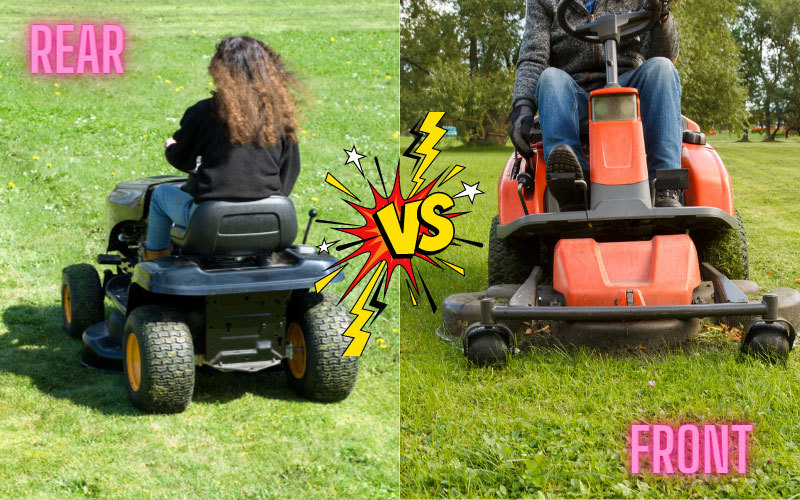Picking between a front-wheel vs rear-wheel drive lawn mower can be a tough choice if you don’t know how the two differ. Unfortunately, you won’t find a hint on the boxes telling you which one you should buy. So, before you guess which lawn mower will suit you best, let me explain the difference between the two options and help you decide which is best for your lawn.

What is Front-Wheel Drive?
A front-wheel-drive lawn mower has two front-drive wheels powered by the lawn mower’s engine that pull the lawn mower across the ground. A lever on the handlebar engages the front-drive wheels. By engaging and disengaging the lever, the drive wheels start and stop.
What is Rear-Wheel Drive?
A rear-wheel drive lawn mower is the complete opposite of a front-wheel drive lawn mower. The drive is generated by the rear wheels or the rear roller, depending on the specific lawn mower design. Again, you’ll find a lever on the handlebar to engage and disengage the drive wheels/roller. Also, instead of being pulled along, a rear-wheel drive lawn mower is pushed along.
Pros and Cons of Front-Wheel Drive (In My Opinion)
So, as you can see, there isn’t really that much of a difference between front-wheel vs rear-wheel drive lawn mowers by just looking at them. But, there is quite a difference when it comes to handling. Let’s take a look.
Pros of Front-Wheel Drive Lawn Mower
Let’s start off by checking out the pros of front-wheel drive lawn mowers. There are 3 main benefits to buying a lawn mower with front-wheel drive.
Cost to Purchase
The front-wheel drive mechanism tends to be a bit simpler than that of a rear-wheel drive lawn mower, so you’ll see a definite reduction in price. Therefore, if you are looking for a self-propelled lawn mower that’s budget-friendly, then a front-wheel drive mower is a good option.
Easier to Control
One of the big selling points for front-wheel drive lawn mowers is the fact that they are easier to control. Their easy handling comes down to the fact that when you lift the front wheels, the lawn mower stops moving regardless if the drive is engaged or not. So, you won’t find a front-wheel lawn mower pulling you along uncontrollably.
Good for Flat Yards
If your lawn is nice and flat, then a front-wheel drive lawn mower is an excellent choice. There is no point in paying extra money for a rear-wheel drive lawn mower if you don’t have any hills in your yard.
Cons of Front-Wheel Drive Lawn Mower
So far, front-wheel drive lawn mowers sound like a pretty good choice. But here are a few things I didn’t like after using one for a few years.
Not a Good Choice for Irregularly-Shaped Yards
Because my flowerbeds are different shapes, the edges around my lawn are all pretty curvy. Steering around curved edges with a front-wheel drive lawn mower care be a bit of a struggle. This is because front-wheel drive lawn mowers require all four wheels on the ground to steer. So, you end up dragging the mower front side to side to navigate curves on a lawn. Mowing in a straight line is easy enough, but anything else takes extra effort.
Not Good Lawn Mowers for Hilly Yards
When mowing up hills or banks, the front wheels of a front-wheel drive lawn mower can lift up slightly as most of the weight is in the rear of the lawn mower. The problem with this is you lose traction. So, trying to mow up a hill with a front-wheel drive mower means you’ll end up having to push the lawn mower to help it along.
Not Great Traction
So, not only can you lose traction on hills, but you can actually lose traction on flat ground as well. I found that this mostly happened when using a bag to collect grass clippings. As the bag fills with clippings, the lawn mower’s rear becomes heavier, and the front wheels begin to lift and lose traction. This can happen even faster if you are mowing slightly wet grass.
So, unless you don’t mind having to give a front-wheel drive lawn mower an extra push every so often, you might want to go for a rear-wheel drive instead.
Pros and Cons of Rear-Wheel Drive (Again…Just My Opinion)
Now it’s time to look at the rear-wheel design lawn mower and see how they fare. Let’s start off with the pros of rear-wheel drive lawn mowers.
Pros of Rear-Wheel Drive Lawn Mower
After having used both front-wheel and rear-wheel drive mowers, I’ve come up with a few pros that stand out when it comes to rear-wheel drive lawn mowers. Here are 3 areas where I think the rear-wheel drive design outperforms the front-wheel drive models.
Good Traction
First off, the traction on a rear-wheel lawn mower is far superior to that of a front-wheel drive lawn mower. This is because most of the weight of the lawn mower is over the drive wheels. So even when using a bagging system, there isn’t an issue with traction.
Easier to Mow Irregularly-Shaped Yards
If you have a lawn shaped with curves around the edges, then you won’t have a problem with a rear-wheel drive lawn mower. This is down to the fact you can slightly lift the front wheels to steer. So, rather than struggling with all four wheels on the ground to achieve steering and drive, you can lift the front wheels just a bit and still have the rear wheels drive the lawn mower forward.
Better in Achieving a Straight Cut
If you like to make super straight lines in your lawn when you mow, then you’ll find it much easier with a rear-wheel drive lawn mower. Again this comes down to maneuverability and the fact that you can make small steering adjustments with little effort.
Cons of Rear-Wheel Drive Lawn Mower
So far, so good, but now it’s time to go over the cons of rear-wheel drive lawn mowers. Let’s take a closer look.
Harder to Corner
Cornering is a technique that takes some getting used to when mowing with a rear-wheel lawn mower. You can’t just disengage the drive and make a turn like when using a front-wheel drive lawn mower. The problem is that when the rear wheels of a rear-wheel drive lawn mower are not engaged, they usually won’t turn.
So, the only way to turn is to engage the drive and make a fast turn with the front wheels lifted up. Now after some time, you’ll probably get the hang of it, but in the meantime, your lawn mower might be controlling you rather than you controlling your lawn mower.
Can Become Rear Heavy
A rear-wheel lawn mower can get a bit heavy on the back. Now, this isn’t going to cause traction issues. If anything, the extra weight will improve traction. But you might find the front could become light and begin to lift. I’ve had to deal with rear-wheel lawn mowers that get so heavy in the back and light in the front that I’ve needed to lift up the handlebar just to keep the wheels on the ground.
Now, this only happened when I had a full clipping bag. Nevertheless, this was a problem I wish I didn’t have to deal with when mowing my lawn.
Higher Cost to Purchase
If the front-wheel drive lawn mower is the cheaper option, then that would make the rear-wheel design more expensive. We are not talking about a difference of hundreds of dollars, but maybe enough to make you think twice.
Factors that Will Impact Your Decision
To summarize all the pros and cons of front-wheel vs rear-wheel drive lawn mowers, I’ve put together this table. The table shows what I believe are the most important factors to consider when choosing between the two different drive systems.
RWD vs. FWD Lawn Mower Comparison
| Factors to Consider | Front-Wheel Drive | Rear-Wheel Drive |
|---|---|---|
| Lowest Cost to Purchase | X | |
| Easiest to Control | X | |
| Easiest to Corner | X | |
| Easiest to Steer | X | |
| Best Traction | X | |
| Good For Flat Yards | X | X |
| Best for Hills & Slopes | X | |
| Best Around Flower Beds | X |
My Experience of FWD vs RWD (+ Recommendation)
To make things a little easier, I’ve put together a selection of different types of yards with varying characteristics. Then I’ve identified which lawn mower I believe would be the best fit for each situation. Now I’m not as young as I used to be, so I’m not looking to wrestle a lawn mower around my yard. Instead, I’m looking for the mower that is best-suited, safest, easiest, and of course, the best value.
| Yard Type | Front-Wheel Drive | Rear-Wheel Drive |
|---|---|---|
| Small Lawn | X | X |
| Medium Lawn | X | X |
| Large Lawn | X | X |
| Square Straight Yard | X | |
| Square Straight Yard with a Small Slope | X | |
| Yard with Lots of Curvy Flower Beds | X | |
| Yard with a Big Slope/Bank | X | |
| Yard with Lots of Flower Beds and a Big Slope | X |


Leave a Reply